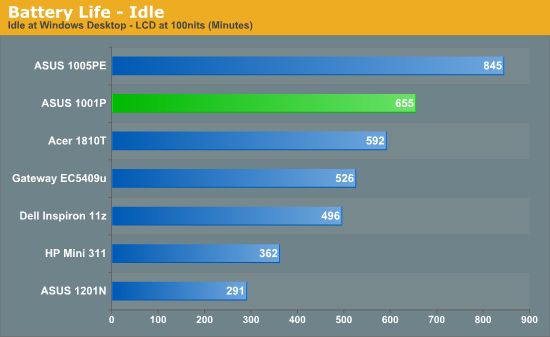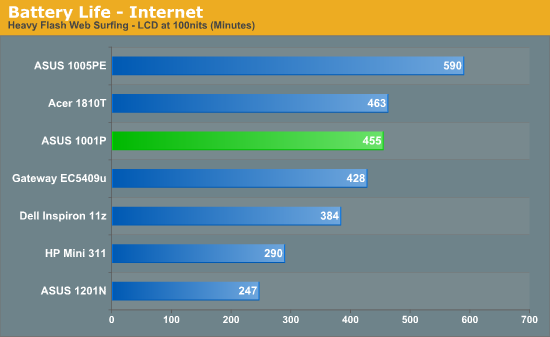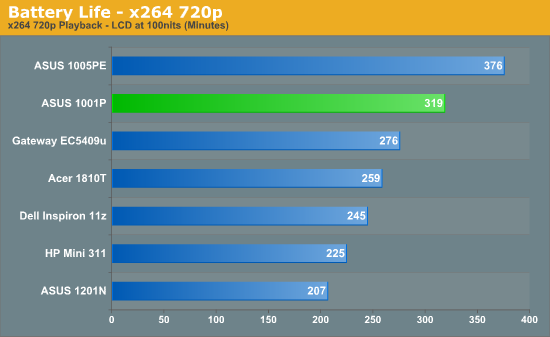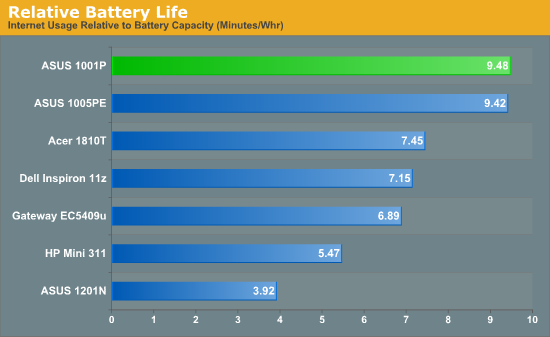Asus Eee PC 1001P: Our Favorite Netbook
by Vivek Gowri on March 16, 2010 11:30 PM EST- Posted in
- Laptops
Asus Eee PC 1001P: Battery Life
In our earlier tests of the Pine Trail-based 1005PE, we noted that the real victory of the new Atom processors was in the significantly reduced power consumption of the entire platform. This makes itself very noticeable in real world usage, with most 6-cell Pine Trail netbooks rated for anywhere between an impressive 8 hours to an absolutely astonishing 14 hours in the case of the 1005PE. The 1001P is rated at 11 hours of battery life—right in the middle.
While none of the devices actually reach their battery life targets in the real world (an idle battery life test isn't at all representative of typical use), having that much capacity on hand makes the new line of netbooks even more portable than the last. With 10 hours of battery runtime in the tank, the amount of mobility you're afforded is pretty refreshing. No more worrying about power cords, wall outlets, or the dreaded "will I have enough battery left after class to write this paper?" questions. Let me put it this way—the 1001P has better battery life than my first two iPods. Yeah.




Based on the test results, we can see that the 1001P has lower battery life than the 1005PE, and similar runtimes as the 1005HA. This is as expected, because of the 48Wh battery; the top end 1005 models tested both had larger capacity 63Wh batteries. So, the generational gap essentially means that you can achieve the same battery life results from a smaller and lighter battery. And that's why netbooks still remain relevant—double digit battery life on a $300, sub-3 pound machine that still runs Windows is a pretty awesome concept, languid performance notwithstanding.










63 Comments
View All Comments
Taft12 - Wednesday, March 17, 2010 - link
Has anyone made a netbook since the Dell Mini 9 (owned and loved by me) that has no moving parts?This should be a design decision netbook makers should strive for, but I don't even know if anyone has even managed this feat since Dell did 1.5 years ago.
tlbj6142 - Wednesday, March 17, 2010 - link
"Honestly, I would rather have XP on a netbook—any netbook. Win7 Starter is annoying and unsightly when compared to the "full" version of Win7 Home Premium and shouldn't exist in any corner of the market with its lack of Aero and the ridiculousness of a fixed desktop background."Why does this bother so many people? With a 10" screen do you ever even see your background? I know on my 15" laptop, I never do.
Areo has a couple of nice features (alt-tab layered look), but most are annoying. Especially the blurry "see through" window borders.
The real advantage Win7 has over XP is readyboost support. A $20 USB makes a world of difference in performance. Even on a 64-bit dual-core machine with 4G of ram.
straubs - Wednesday, March 17, 2010 - link
I find the very suggestion that "memory over USB" is somehow faster than extremely fast DDR3 memory connected directly to the motherboard to be completely preposterous.SunSamurai - Tuesday, March 23, 2010 - link
That is completely preposterous, so its a good thing no one in their right mind ever suggested that.Replace DDR3 with Hard Drive and thats what its for. It's suppose to supplement the hard drive to provide less thrashing the pagefile.
Its still crap, and all it is is a buzzword selling point for dbag sales people in the tech department to toss around at consumers. Its almost as bad at them adding dual-core Ghz speeds together to come up with 5Ghz when really selling a 2.5Ghz chip.
Toss these people in jail or fine them please!
nubie - Wednesday, March 17, 2010 - link
I think you completely misunderstood the point of readyboost.Flash ram has much lower latency than any physical medium (IE spinning disk)
Thus if you intelligently cache the OS and some apps to Flash you can mask HDD latency, and probably improve on hard disk caching by allowing flash cache.
Hard drive latencies have a large effect on lag issues in a low-ram computer.
strikeback03 - Friday, March 19, 2010 - link
Suppose that is a good point, has anyone tested Readyboost in Win7 to see if it is useful yet? I can't, I run Windows off an X25-M so I'm sure it is faster than a flash driveTaft12 - Wednesday, March 17, 2010 - link
What bothers people is the unnecessary crippling and step backwards from the "antiquated" Windows XP. We should be moving forward, not backwards.Also, Readyboost was shown to provide almost no benefit except in contrived benchmarks back in the Vista days and I doubt things have changed since.
mschira - Wednesday, March 17, 2010 - link
I am not giving away my eee 1000h,It has a nice factory build in button to overclock to 1.8Ghz - effectively the fastest Atom CPU around, and boy it needs every single Hz it can get.
Asus overclocks the CULV platform, why not Pineview?
2Ghz? where are you?
M.
synaesthetic - Wednesday, March 17, 2010 - link
Using ASRock's OCTuner utility, I've seen people overclock the HP Mini 311 (N270, nvidia ION) to 2.4GHz stable without a serious impact on battery life (lose one hour at most).I still haven't seen anything to make me want any other netbook more than the HP Mini 311, purely due to the presence of ION and the ability to increase clock speed by 50%.
QuietOC - Wednesday, March 17, 2010 - link
This sounds like the best current netbook. I can't understand why anyone puts up with the garbage LCDs. I didn't know how good my 1000HA was until I got a 11" CULV. I agree the Atom should be clocked at 2GHz--which works on the Eee PC 1000 series. Intel actually does offer one Atom model rated for that speed but it is not Pineview.